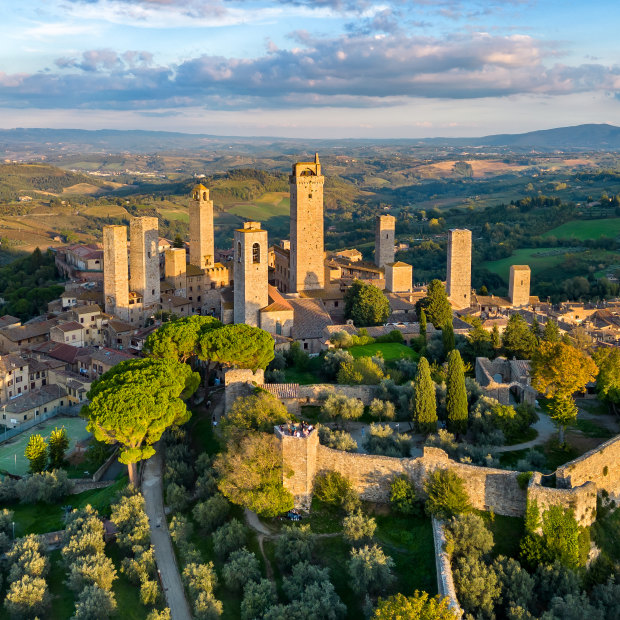
San Gimignano’s slender towers draw walkers to a welcome rest stop on the Via Francigena.Credit: iStock
Prayers and blisters. Did we take a wrong turn back there? Is God watching over us? Will we arrive in time for aperitivi? Like pilgrims jostling for holy water, our random thoughts during long days of walking under a Tuscan sun mix the spiritual with the banal.
These free-range flights of fancy liberated on the Via Francigena – of sore feet and divine intervention – link me to 1000 years of history and the generations of pilgrims for whom all roads led to Rome.
In the Middle Ages, the Via Francigena was Europe’s overland spine, a pilgrimage often likened to Spain’s better-known Camino de Santiago – but much longer, centuries older and, these days, far less crowded.
The route begins in the English cathedral city of Canterbury, cuts through France and Switzerland, traverses some of Europe’s most spectacular alpine passes and meanders through the splendid wine country of central Italy to end in the holy city of Rome.
For an age, I’ve dreamed of walking the Via Francigena. In another life, I would have a spare four months to devote to the full go-to-whoa 2000 kilometres.
For now, I can manage a week-long hike across Tuscany, a path strung between some of the region’s most beautiful hill towns and fuelled by the pleasures of the Tuscan table.
From episcopal slippers to digital daypacks
The route might have been forgotten if not for Archbishop Sigeric of Canterbury, who noted the names of places he stayed during his pilgrimage in 994.
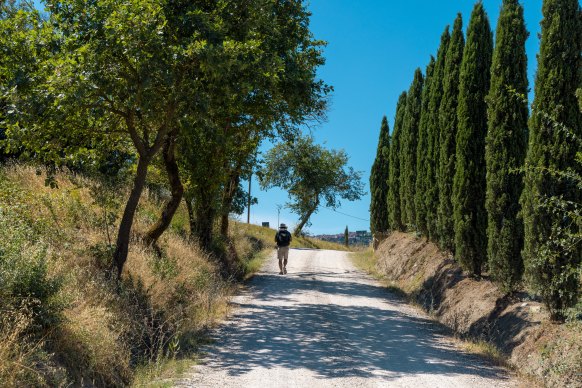
Cypress trees, farmland and forests adjoin the gravel paths of the pilgrimage route.Credit: Shutterstock
After centuries of disuse, the tangled old pilgrim trails have been rehabilitated, signposted and modernised with app support. It’s growing in popularity as a slow-travel option and a sidetrack through Europe’s most touristic countries.
The good bishop most likely travelled by mule rather than spoil his episcopal slippers; we’re walking a “soft” version of the pilgrimage, our luggage sent ahead every morning to the next hotel.
We fill our day packs with litres of water, plus notebooks, phones and a power bank – the accoutrements of the digital pilgrim – and set off from the hill town of San Miniato, an hour west of Florence by train.
This place is a find: a seemingly sleepy stone-walled village with truffle-focused restaurants of excellent quality and a clutch of sleek wine bars.
At the town’s deli, in my schoolboy Italian, I ask for panini with prosciutto and cheese and a bottle of wine for the day’s walk. The shopkeeper makes the rolls and asks with a wink whether I prefer white or red.
I confess I’m only joking about the wine – sto scherzando – and her co-workers splutter with laughter. “But for me,” she smiles and shrugs, “it’s normal”.
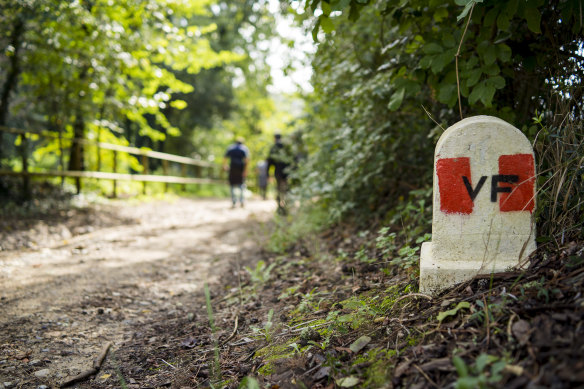
Trail markers are a guide and a comfort on the path through Tuscany.Credit: Getty Images/iStockphoto
We strike out across a valley with a fresh northerly breeze at our backs and a big dry sky above. Within the hour we’re at a red-and-white Via Francigena signpost indicating the distance south to Rome and north to Canterbury.
From here the path winds into Tuscan countryside from central casting: a landscape of vineyards, olive groves, ripening corn and wheat, strewn with ramshackle stone farmhouses and avenues of arrow-head cypress.
We follow gravel tracks flanked by poppies and daisies and cornflowers woven into the drying summer grass. For all its apparent order, though, the landscape is less preened than I’d imagined, wilder and more heavily forested.
“C’est magnifique,” offers a wiry Frenchwoman of a certain age, who quickly overtakes us. We join two Scottish women but they, too, are walking at a business-like pace and we fall back. It’s a high-summer week, yet we see less than two dozen walkers.
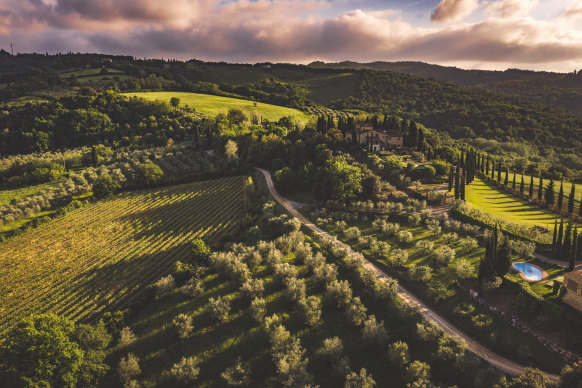
A farmstay is a welcome part of the walking experience on the Via Francigena.
A few pods of cyclists flash past. I find I’m nettled by all that metal and Lycra and helter-skelter haste. Medieval pilgrims didn’t make the journey on mountain bikes. But then I correct myself – nor did they send Samsonites ahead by courier.
Today’s walk is 25 kilometres. We start briskly, slowing with fatigue as the afternoon temperature spikes. The steady incline into the old spa town of Gambassi Terme seems interminable.
We pause at a 12th-century church on the outskirts, but by the time we reach our hotel we’ve no energy to walk back into the centro storico and its hot baths. That night we give thanks for pizza tartufo and vernaccia, the region’s crisp white wine.
Of medieval skyscrapers and sacred erections
Next morning we spy the famed towers of San Gimignano and it reappears every couple of hours to spur us on.
Today’s 18-kilometre walk, beneath low cloud and drizzle, is a little cooler. We see no pilgrims on the path – we have the Via Francigena to ourselves. The silence is companionable, the rhythm of footfall meditative.
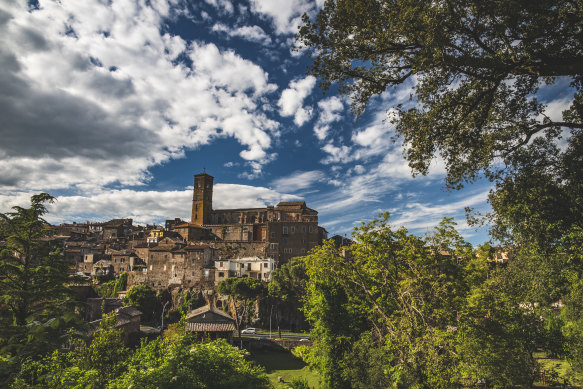
Food, wine and sound sleep are the rewards for scaling paths to the hilltop towns.
In the uplands approaching San Gimignano we stumble onto a dove-grey Romanesque church set in a cypress grove, one of many surprises sprinkled along the route.
Inside the empty church of Santa Maria Assunta in Cellole, my eye is drawn to the arched nave and there, enveloped in golden light, is a panel painting of Christ on the cross with – I blink, blink again – what looks like an outsized erection.
It’s a surprise though not a shock. On a visit to Milan a decade ago, I met a Catholic priest and scholar who explained this iconographic tradition as a way of emphasising Christ’s humanity.
Half an hour later we burst out of the woods onto the bitumen road to San Gimignano. Mostly we walk on gravel tracks shared infrequently with farm vehicles, but the Via Francigena at this point hugs the road, and we’re channelled alongside weekend traffic.
We pick up the pace, lured by glimpses of the hill town’s assertive bristle of 14 medieval skyscrapers. Before long we enter one of the town’s stone-arched gates. Where medieval pilgrims had to contend with wild boars and bandits, a seething mid-summer crowd of day-trippers has been sent to try us.
That night at a lovely outdoor restaurant with views of the storms sweeping past San Gimignano’s slender towers, we’re seated next to a young Italian couple keen to talk about the realities of family life, the financial stress of high rents, and the country’s mash-up of regions and dialects.
To Monteriggioni with Georgia on our minds
Striking out again through this mysteriously timeless landscape – walking in the footsteps of ghosts – I’m grateful to the couple for their vivid picture of lived reality, its stresses and strains, in Prime Minister Georgia Meloni’s Italy.

Walking through the fields of Tuscany inspires quiet contemplation.Credit: Getty Images
We quickly fall into a routine, propelled by the simple joy of walking that has inspired generations. Lodge the suitcases in the lobby by 8.30am, collect a pre-ordered panini from the kitchen, fill water bottles, walk to the next hill town (11 kilometres to 25 kilometres), check in and rest.
Emerge when the day has cooled, stroll, visit a church, a belltower, a museum, aperitivi, dinner – then dreamless sleep.
The routine may be set, but the route itself continues to surprise. On the way to an agriturismo, or Italian farm-style accommodation, we pass a pre-Christian, open-air thermal pool, said to have been enjoyed by the Romans and before them the Etruscans.
A single swimmer paddles gingerly as we pass, joined by what appears to be an otter. We later learn it’s an enormous South American river rodent, named locally a castorino (little beaver). It was introduced a century ago for fur farming but is now running wild in northern Italy’s rivers and enjoying Roman baths.
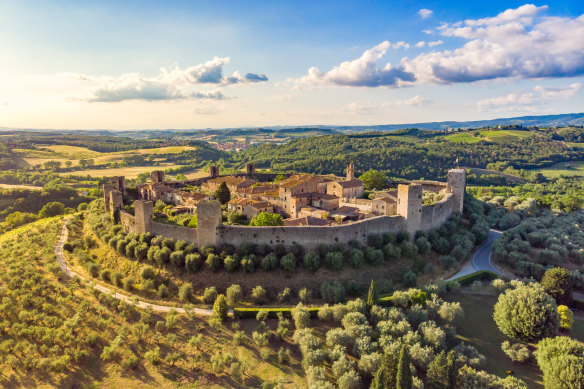
Fortified town of Monteriggioni, part of the pilgrimage route for more than 1000 years.Credit: Getty Images
The next day we set out for Monteriggioni, a fortress ringed by 14 squat towers. On the way we pause at the 12th-century wayside monastery of San Salvatore, an exceptionally beautiful Romanesque church bearing a rich gold and crimson altarpiece and a stop on the Via Francigena since the time of Sigeric.
Entering Monteriggioni’s Porta Romea, we climb the ramparts and stroll through a paved square and a warren of two-storey stone homes, with high shuttered windows painted bottle green.
We’re in time for lunch, and we find a garden restaurant flanked by tower walls, serving brunello from nearby Montalcino, pasta from Monteriggioni wheat and ragu of cinghiale, the prized Tuscan wild boar.
Green cathedrals to stone villages
Next day, I sense the cinghiale must be close by as we tramp through tracts of silent oak forest. It’s always a relief to spy the track markers etched with the letters “VF”, and particularly today. The forest is a cathedral of deep layered greens, silent and damp.
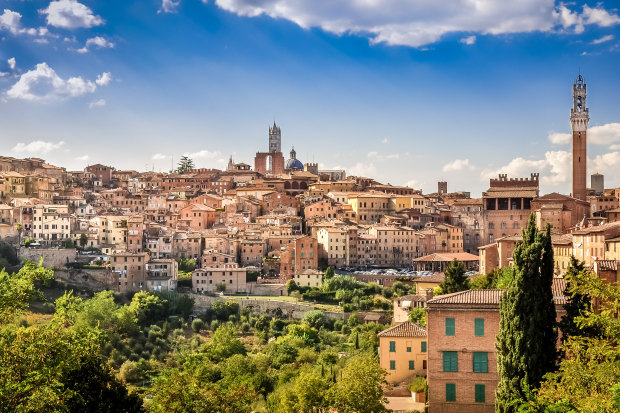
Siena, seat of medieval power and venue for the colourful Palio horse race.Credit: Getty Images/iStockphoto
Ahead is a young woman strolling along the track with a dreamy air. I stop to ask if she, too, is on the Via Francigena. She’s American, has never heard of it, and explains that she’s staying nearby and felt like stretching her legs. We offer some details about the pilgrim route to Rome and she asks where we’re from.
“You’ve walked from Australia?” she gasps and reaches for her phone. “Can I take a photo?” I’m quick with a clarification and the phone disappears.
The forest gives way to open fields and, skirting a stone village, we pause in the welcome shade of a mighty oak, its gnarled trunk the girth of a sumo wrestler. The buildings look deserted, none more so than a sublimely elegant fairytale castle closed to outsiders.
Our destination today is Siena, seat of medieval power and art and historical rival of Florence. It’s another 25-kilometre trek, and now very hot, so we pull in at a rest stop named “La Villa” serving drinks and snacks to pellegrini (pilgrims) – payment by donation.
Owner Marcello, a former barber, is chilling in one of his upholstered chairs. Marcello reports that the castle, named la Chiocciola, or the snail, due to its tower’s spiral steps, has been held by the same family since the 15th century and remains mired in some ancestral dispute.
There are more surprises. A few hours shy of Siena we pass a stone pyramid, erected in the 18th century to celebrate the draining of the marshland and, according to a sign, the banishing of “deadly miasmas”. And on the hills outside Siena we glimpse a man leading a magnificent white horse through the forest.
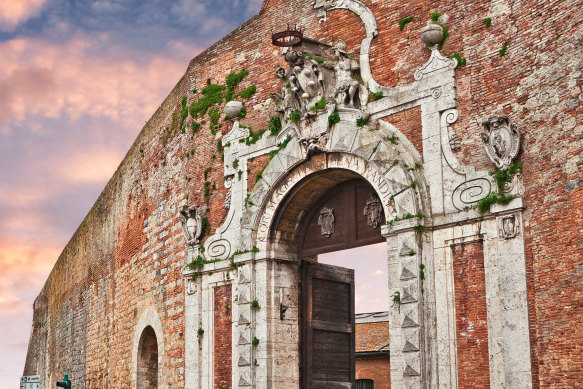
Porta Camollia, Siena’s northern city gate, can be a welcome sight for walkers on the pilgrim trail.Credit: Getty Images/iStockphoto
Limping through Siena’s northern gate, the Porta Camollia, we find a city alive with twilight energy. Preparations are under way for the famous, though controversial, Palio horse race in a few days. Its central Piazza del Campo is covered temporarily in rammed earth.
Members of the city’s 17 contrade, dressed in medieval regalia, march through the maze of cobbled streets singing at fever pitch. We join them, a couple of foot-sore pellegrini carrying on a 1000-year-old tradition.
We’re walking in midsummer and the temperatures have begun to spike. At 9pm in Siena we sit down to an outdoor meal and the heat is so intense that the white fat of the prosciutto browns before our very eyes.

View above Piazza del Campo.Credit: Getty Images
The sommelier remarks on the beauty of the surrounding countryside and its many “secrets”. I show him pictures of the places we’ve discovered and he replies that the tower of La Chiocciola and the old Etruscan baths are precisely the secrets he has in mind. “These are places that visitors rarely see even if they have a car,” he says. “That Italians rarely see.”
Walking days on end across this long-settled landscape, pilgrims connect with great spans of history. They luxuriate in slow contemplative time, find their fitness, breathe, learn. Awaken not so much to the presence of the divine as the force of shared humanity. The discovery of well-kept secrets touches a different nerve. It turns a journey into a quest – a discovery.
Five more things to see and do
Sample San Miniato’s truffles
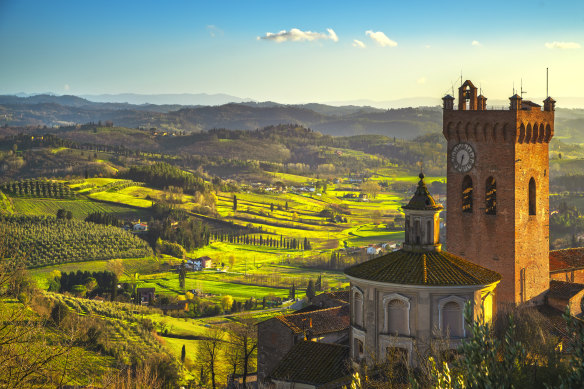
The Cathedral of San Miniato has commanding views, and the truffle menus demand attention too. Credit: Getty Images/iStockphoto
The area around San Miniato is renowned for its white truffles and L’Upupa, a truffle-focused osteria, is a gem. The decor is humble – quirky racing-car memorabilia – but the food is refined. One antipasti option is a procession of five separate truffle-based dishes. Three courses with wine cost us $180. This charming hill town has an abundance of good bars and eateries.
Slowly does it in San Gimignano
One of the highlights of the walk is the slow reveal of San Gimignano and its slender towers. The hill town is one of the highlights of any Italian itinerary. Avoid a weekend arrival if possible. In the centre of town is La Mandrogala, a pretty restaurant serving home-made pasta and local produce in a terrace garden with views of the famed medieval skyline. The wine list is extensive and service friendly yet professional. Three courses and a bottle of vernaccia, the excellent local white wine, set us back $220.
Take to the waters in Tuscany
The Tuscan leg of the Via Francigena is dotted with thermal pools. Some, such as the spa baths of Gambassi, are in the hills. Others, such as the Etruscan-era pool known as La Caldene (on the outskirts of the village of Gracciano dell’Elsa) are found in the valleys. All are a welcome balm for footsore walkers.
Make it up to Monteriggioni
It’s a long uphill hike to the piazza at the centre of this exquisite crown-shaped hill town, so you really deserve a long lunch on arrival. Settle at a garden table at Da Remo, in a 14th-century building flanked by castle walls. Handmade pasta spiked with local saffron, charcoal-grilled chianina beef and a bottle of brunello di Montalcino are your reward.
By the book in Siena
In Siena, a Renaissance jewel easily missed is the Piccolomini chapel and library – it’s an annex to the liquorice-all-sorts-coloured cathedral. The walls and ceilings were frescoed with vibrant realism by Pinturicchio in the early 16th century and richly illustrated choir books of ethereal beauty line the walls. In the centre stands a classical statue of the three naked graces.
The details
Walk
In Australia, UTracks does self-guided and small-group active holidays in Europe, including walking trips along the Via Francigena in Italy ranging from 50 days to shorter sections such as the nine-day “Best of Tuscany” walk described above. See utracks.com
Book
The trip starts from $1770 and includes daily luggage transfers, accommodation in three-star hotels and agriturismi, maps, a handy smartphone app and emergency hotline.
Prepare
Walking the Tuscan stretch of the Via Francigena isn’t strenuous, but it’s certainly demanding. Some fitness prep – at the gym, or a few day walks with a 7-kilogram to 10-kilogram pack in the lead-up – will make all the difference to walking pleasure. Choose your season wisely. A walk “under the Tuscan sun” is less romantic in searing mid-summer temperatures.
Fly
Airlines including Emirates, Etihad and Qatar fly daily to Milan and Rome; Florence and the hill towns of Tuscany are easily accessible by train. See emirates.com; etihad.com; qatarairways.com
The writer walked courtesy of UTracks.